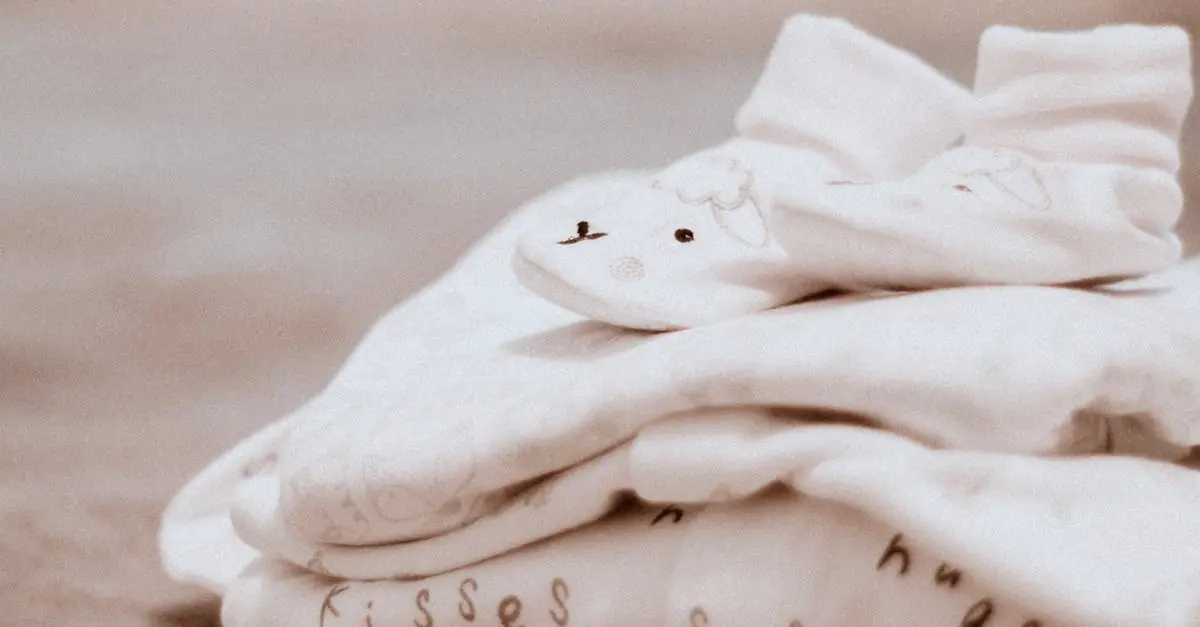When it comes to dressing a baby, parents often find themselves in a fashion dilemma. Do those tiny feet really need socks? After all, they’re not exactly walking the runway yet. But before tossing those adorable socks aside, let’s explore the world of baby foot fashion and the surprising benefits of keeping those little toes covered.
Babies may not be strutting their stuff just yet, but their feet can get cold faster than a toddler can throw a tantrum. Keeping them cozy not only adds a layer of warmth but can also prevent those precious tootsies from turning into ice cubes. So, are socks a necessity or just a cute accessory? Let’s dive into the debate and see if those socks are worth the fuss or if it’s time to let those baby feet breathe.
Table of Contents
ToggleUnderstanding Baby Comfort
Keeping babies comfortable involves understanding their temperature regulation needs. Babies can lose body heat rapidly, especially through their extremities. Socks can help maintain warmth, making them a practical choice in cooler weather.
The Importance of Temperature Regulation
Temperature regulation plays a vital role in a baby’s overall comfort. Babies require a stable environment to thrive, and exposure to cold can lead to discomfort or even health issues. Socks help retain warmth, particularly in cooler room conditions or during colder seasons. Parents should monitor their baby’s body temperature regularly. Signs that indicate a baby needs warmth include cold feet or noticeable changes in behavior.
Factors Influencing Baby’s Sock Needs
Several factors influence whether a baby needs socks. Seasonality, for instance, impacts temperature; colder months often necessitate additional warmth. The indoor temperature also matters; rooms that are chilly might require socks for extra comfort. Another consideration is the baby’s mobility; active babies might kick off socks, reducing their effectiveness. Choosing the right materials also counts; breathable fabrics ensure comfort without overheating. Parents need to assess these factors to determine the appropriate sock usage for their babies.
Benefits of Babies Wearing Socks
Socks offer essential benefits for babies. They provide warmth and safety for tiny feet that are sensitive to temperature changes.
Warmth and Comfort
Keeping feet warm enhances a baby’s overall comfort. Cold feet can lead to fussiness or restlessness, making it difficult for babies to relax or sleep. The use of socks acts as a barrier against the chilly air, helping to regulate body temperature. Layers of material, especially soft cotton or wool, trap warmth effectively. Parents should regularly check their baby’s feet to ensure they remain warm, especially during cooler months or in air-conditioned rooms. Babies can benefit from socks that fit snugly without being too tight, allowing for ease of movement and breathability.
Protection Against Injuries
Socks serve as a protective layer against minor injuries. Babies often explore their surroundings, and soft fabric can prevent scrapes from hard surfaces. A well-fitted sock reduces the risk of slipping on smooth floors, which can lead to falls. Additionally, socks prevent dirt and germs from coming into contact with delicate baby skin. Parents can choose socks with non-slip grips on the sole, providing extra stability during those early walking attempts. Prioritizing foot protection ensures babies can play safely while their feet remain shielded.
Situations When Babies Might Not Need Socks
Certain situations exist where babies might not require socks. Parents can evaluate these circumstances to enhance their child’s comfort.
Indoor Environments
Indoor spaces often have controlled temperatures. Babies generally stay warm in a cozy home without socks. Soft blankets or warm footed pajamas provide adequate warmth, creating a comfortable atmosphere. Monitoring the room temperature helps parents determine if socks are still necessary. If the environment feels warm, it’s perfectly acceptable to let little feet breathe.
Warm Weather Considerations
Warm weather calls for lighter clothing options. High temperatures make socks unnecessary, as babies’ feet can overheat easily. Light cotton apparel allows air circulation while preventing sweaty feet. Parents can opt for open-toed footwear or simply let babies go barefoot on safe surfaces. Keeping an eye on overall comfort ensures that little ones remain content and happy in the sun.
Socks Material and Design Considerations
Selecting the right socks for babies involves careful consideration of materials and fit. Both factors contribute significantly to a baby’s comfort and foot health.
Choosing Breathable Fabrics
Opting for breathable fabrics ensures that babies remain comfortable throughout the day. Cotton serves as an excellent choice due to its ability to allow air circulation while keeping feet warm. Wool also provides insulation and breathability, accommodating varying temperatures. When prioritizing fabric selection, avoiding synthetic materials is wise, as they can trap heat and moisture. Many parents therefore prefer materials that are soft and gentle against sensitive skin, reducing the risk of irritation. Additionally, checking for tags highlighting organic or hypoallergenic options can offer extra peace of mind.
Importance of Proper Fit
Ensuring proper fit is crucial for baby socks, impacting both safety and comfort. Socks that are too tight can restrict circulation, while those that are too loose may slip off or bunch up. A snug but comfortable fit should allow for movement without pinching. Going for designs with stretchy bands at the cuff helps maintain the sock’s position without causing discomfort. Many brands provide sizing charts, so parents can find the ideal fit for their baby’s age and foot size. Adequately fitting socks not only prevent slips but also promote overall foot health as babies begin to explore.
Ultimately the decision to dress babies in socks hinges on several factors including temperature and comfort. Parents should prioritize warmth and safety while also considering the season and indoor conditions.
Choosing the right materials and fit is essential for ensuring that socks serve their purpose without causing discomfort. As babies grow and become more mobile monitoring their needs will help parents make informed choices about sock usage.
By staying attentive to their baby’s cues and adjusting accordingly parents can strike a balance between warmth and freedom of movement. This thoughtful approach will ensure that little ones remain cozy and happy as they explore their world.




